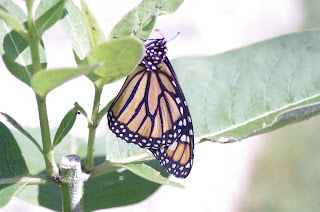I have a milkweed seed pod on the front porch–I don't remember why I put it there, but it has been there for a couple of weeks–and today when I walked out the front door there were seeds (sans fluff) all over the porch, and other seeds (with fluff) caught up on things like the plants on the porch, the railings, and a spider web built between the porch and the steps. I swept the fluffless seeds into my hand and scattered them in an area of the front lawn where I want milkweed to grow, and any that were caught I released to the wind. I left the pod on the porch to release the rest of its seeds on its own time. Who knows where there will be milkweed growing next summer? For what I have heard from other people, it's not that easy to grow milkweed intentionally from seed; it might be easier if you buy plants, but a lot of people I know who have planted seeds have been unsuccessful in growing it. So I don't plant it, I just let the seeds go where they want. I tend to let it grow wherever it sprouts, even if it ends up growing somewhere I don't want it to be, like in the middle of the lawn, or in the rock garden. And since almost every monarch caterpillar that I found in my backyard this year was found on milkweed that was growing somewhere I didn't want it to be growing, it turned out to be a wise choice to leave them there, even if it made mowing the lawn somewhat awkward. Because it was wonderful to find all of those caterpillars on the plants that are there just for them. Granted, there are a lot of other bugs that live on milkweed, but for some reason, this summer they were mostly not to be found in my backyard. There were a few milkweed beetles a couple of months ago, but there haven't been any milkweed bugs since early spring when there wasn't even any milkweed around. There are other bugs, too, that are not milkweed specific, that I would usually find on the plants, but this year there are just not many bugs on the milkweed at all. There's even a milkweed tussock moth caterpillar that I have not seen at all. I don't mind the lack of insects on the plants, because when I have to bring leaves in for the caterpillars I don't want other bugs on them. It's just weird.
I brought in some fresh leaves for the last of the caterpillars yesterday, even though I didn't think it would remain a caterpillar long enough to eat them, and I was right; it nibbled on one of them last night, but today, this was the scene in the enclosure:
New butterfly, chrysalis getting ready for eclosure tomorrow, and the last of the caterpillars crawling around, looking for a spot to become a chrysalis (that is not the spot it chose). I felt a little bit sad that the last of my caterpillars was done being a caterpillar.
This one will be ready tomorrow.
It's first flight was very short–a few wing flutters brought it full circle, to a milkweed plant that was about two feet away from where I was standing when it took off.
And then...
For no reason at all I looked at the underside of a leaf of the milkweed plant next to the one where the butterfly landed, and there was another little caterpillar! So, I still have one more caterpillar to raise. The other summer that I raised monarch butterflies I released the last of them around the beginning of October, I think, so it's not so strange that this one is just coming along now. For all I know, it could be the offspring of butterflies I raised in my house. This one will most definitely be a super-generation butterfly, and will be headed off to Mexico when it reaches butterflyhood.
Backyard Bug of the Day:
Some kind of Syrphid fly, aka flower fly. It only looks like a bee.
Other Bugs:
Grasshopper
Praying mantis
Still trying to get a picture of the bees and other bugs all over this plant...
Mostly the pictures end up looking like this.
They're quite popular with flies, too.
Not a bug. Rather tall for a mushroom, I thought.
Stinkbug nymph
Fruit fly of some kind, I think.
Weevil, I think.
Stand-off? Stinkbug and leaf-footed bug.
Same tree, higher up.
Tree cricket
Tent caterpillars making their way out into the world.
Tree louse?
White hickory tussock moth caterpillars
Sawfly larvae
Tree cricket
Beetle
Spotted cucumber beetle
My bug walk started and ended with grasshoppers. The other was an adult, this is a nymph.
Arachnid Appreciation:
.
.
.
.
.
.
.
.
.
.
.
.
Spider on my bank statement late last night. For reasons of financial privacy I removed it. I don't want my personal information posted on the web. (Sorry. Couldn't resist).
Arrow-shaped micrathena spider with a candy-striped leaf hopper
Flower crab spider



































No comments:
Post a Comment